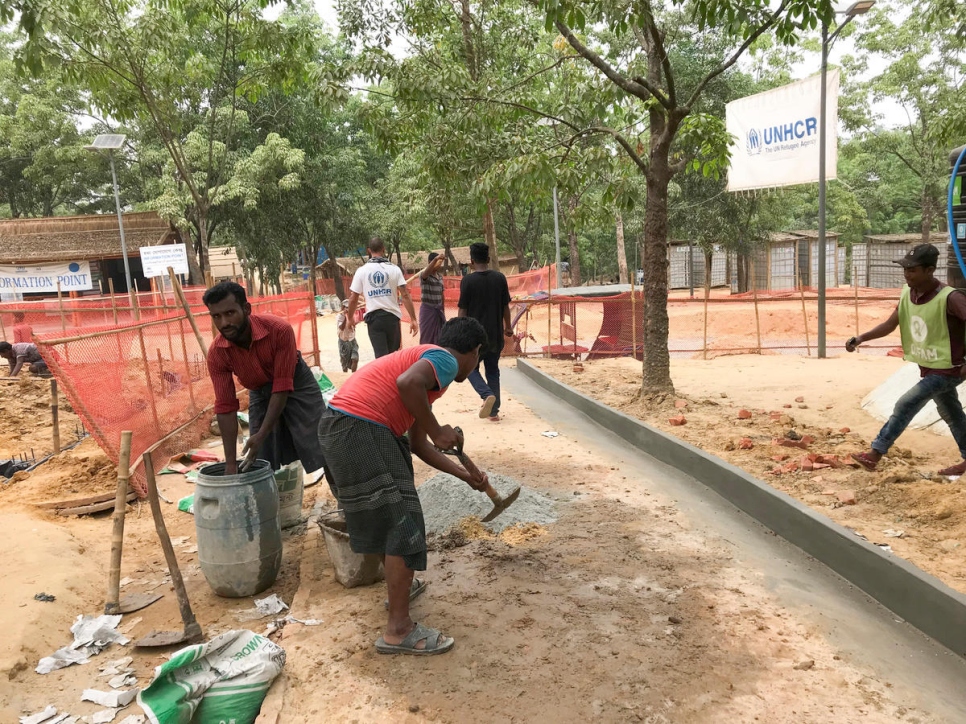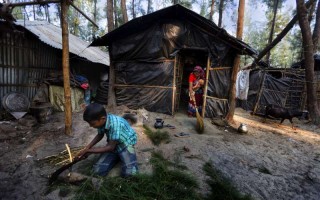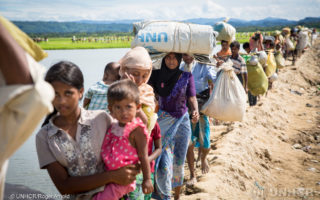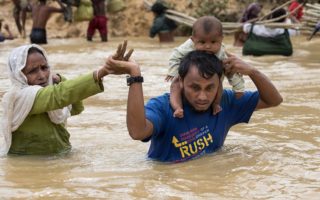
Work gets underway to make the Rohingya transit centre in Ukhia, south-east Bangladesh, safe against flooding in the rainy season. © UNHCR/Caroline Gluck
UNHCR, the UN Refugee Agency is rushing additional aid to Bangladesh where the first monsoon rains have been affecting Cox’s Bazar district and the hundreds of thousands of Rohingya refugees there.
The first of three scheduled humanitarian airlifts carrying additional shelter materials arrived in Bangladesh on 1 May. Its load, 1,400 tents, is the first batch of 10,000 tents that UNHCR will airlift by the end of May. The aim is for the tents to provide emergency shelter for an estimated 60,000 refugees currently residing in areas at high risk of landslides and flooding. Aid is also being moved by sea; this includes additional tents, 170,000 tarpaulins sheets, and other basic items.
Humanitarian partners estimate that between 150,000 and 200,000 Rohingya refugees will be at risk this monsoon season. They are living on land prone to landslides and flooding and are in urgent need of relocation. Of this number, 24,000 people are at critical risk due to severe instability of the land on which their shelters have been constructed.
Since August 2017 more than 670,000 Rohingya refugees have fled to Bangladesh, joining over 200,000 refugees already in the country. In a massive effort to shelter refugees and meet their basic needs, Bangladesh has generously allocated thousands of acres of land that has already been settled on by refugees.
In addition, the government has recently allocated new land for refugees to settle on. UNHCR, IOM and WFP engineers are working around the clock to flatten this land to accommodate those at greatest risk. Heavy machinery and thousands of labourers are working on this. Nonetheless this work is going more slowly than initially anticipated due to the hilliness and instability of the land. UNHCR hope to relocate some 5,000 people to the new land by the end of May.
In the absence of more available and usable land, UNHCR has made temporary emergency relocation arrangements, which will be activated as needed. An estimated 35,000 refugees can be hosted by other refugees living in safer areas; 34,000 refugees can be hosted in communal structures in refugee settlements; and 66,000 refugees can be hosted in tents or other emergency shelters within or adjacent to the current settlements. These arrangements are not a sustainable solution, but they may be life-saving in the short-term.
Meanwhile, in support of Bangladesh’s intensive efforts to ready the refugee settlements for the monsoon rains, UNHCR is further strengthening its own emergency preparedness and response capacity – in an effort to save lives, reduce health, landslide and flood risks and preserve access to settlements.
By the end of May, UNHCR plans to equip all refugee families with shelter kits, which will include bamboo poles, ropes, shelter-grade tarpaulins, sandbags, and tools. In addition, UNHCR is distributing 80,000 pre-monsoon kits to help secure shelters in case of storms, and is stockpiling 160,000 post-disaster response kits to be distributed to refugees, as well as another 30,000 post-disaster response kits to be distributed to any families who might be affected among the host community.
UNHCR has already positioned five hospital tents and emergency health kits in Cox’s Bazar. More medicines and supplies are being ordered.
Refugees themselves are working with us on the preparedness efforts. Refugee community health workers have completed first aid and cyclone preparedness training. Some of them have been trained to be in Search and Rescue Teams. UNHCR and partners are working closely with refugees to develop early warning systems and information campaigns for emergency situations.
On 16 March, UNHCR and partners launched the Joint Response Plan for the Rohingya Humanitarian Crisis seeking more than US$950 million in 2018 to meet the immediate needs of more than 880,000 Rohingya refugees and over 330,000 Bangladeshis in communities affected by the crisis. UNHCR’s portion of this appeal amounts to more than US$196 million.
As of May, only 16 per cent of needed funds have been received. While UNHCR is grateful for the generous and timely support already provided by donors, and particularly grateful to donors for unrestricted contributions which allowed us to continue our work without interruptions, it is vital that UNHCR and partners have more resources available to save lives and improve the living conditions for refuges during the monsoon season, as well as to continue providing timely assistance and protection.
This story was originally published on unhcr.org
For more information on the Rohingya refugee crisis and how you can help, please visit unhcr.ca/bangladesh





